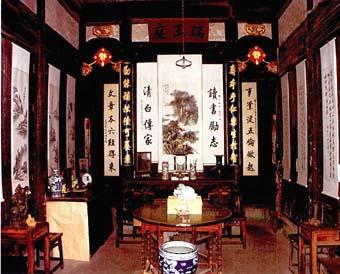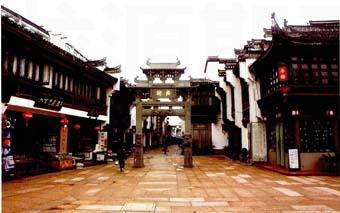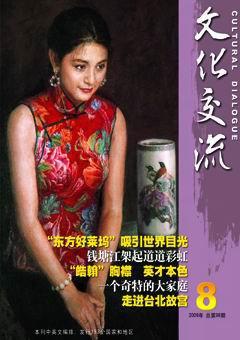Xixian Displays Ancient Charms
Fang Yixin



Wandering on the streets and lanes of ancient Huizhou, the capital city of todays Xixian County, Anhui Province, I am fascinated by the charms of the ancient architecture. As a matter of fact, everything in the town attracts my attention. The small city has three magnificent stone bridges which go back to the Song Dynasty (960-1279), each featuring a combination of architectural majesty and engineering sophistication I have not seen anywhere else. The city is a living museum of ancient architecture: streets, lanes, houses, pavilions, and memorial archways. A river that hugs the town adds a poetic touch to the ancientness of the town and reminds me of some immortal stanzas composed by ancient poets visiting the city more than ten centuries ago.
What fascinates me more is not the tangible magnificence and sophistication. Innovation is what makes the ancient architecture in the county capital outstanding and everlasting.
Take the Xu Guo Memorial Archway on the main street for instance. Architecturally, it is one of its kind and therefore unique in Chinese history. In Xingcheng, Liaoning, a province in northeastern China, I visited two stone memorial archways, which were erected in honor of two generals of the Ming Dynasty. Each has four pillars and is magnificent in many ways. But they pale in comparison with this one. The stone memorial archway in the Summer Palace in Beijing is great. But that one pales too if compared with the Xu Guo Memorial Archway. As for numerous other ancient stone archways scattered across the south, they are altogether in an inferior league. What makes the Xu Guo Memorial Archway stand out is that it has eight pillars.
Xu Guo (1527-1596) was a high-ranking official under three emperors of the Ming Dynasty (1368-1644). He visited Korea as an envoy of Emperor Longqing. During the reign of Emperor Wanli, he provided a winning strategy that successfully put out a rebellion in Yunnan. He was appointed a grand secretary of the Grand Secretariat, a key position in the government cabinet of the dynasty. The official History of the Ming Dynasty has a special chapter dedicated to the biography of Xu Guo. The emperor granted him to have a memorial archway built in his hometown in honor of his decisive part in the military victory in Yunnan.
History does not record who designed it, but his hometown has folklores about its origin. Xu Guo did not start the project for a long while. The emperor was so mystified by the vice prime ministers delay and asked why it had taken him so long. The emperor commented that the delay was long enough to complete the construction of an eight-pillar archway. The story suggests it was as if the vice prime minister had somewhat known the emperor would come up with a suggestion that would make his memorial archway unique. Since the emperor had said eight pillars, Xu Guo expressed his gratitude and went home in a hurry and had the stone structure erected.
So the stone structure has eight pillars, each with a mythical creature as a guardian at its foot. The structure is decorated with patterns in honor of the emperor. It is actually a combination of four memorial archways, each flaunting an inscription written by famed calligraphers. This is the only existing eight-pillar memorial archway in China.
The 500-meter-long Doushan Street is another perfect example of innovative architecture in Xixian. The south-to-north street features ancient residences all facing the south. Stone-paved lanes radiate out from the street to the front gates of these residences. Most of these compounds used to be residences of business tycoons and court officials and other rich people. One of them was a private school. None of them looks alike inside. Architects sought to make a difference and their innovative endeavor shows in details.
I also see a unique tower in the city. The three-story structure looks stately, with 26 wood pillars standing in two rows. It is said that the tower was an imitation of the royal towers in the capital and that the only difference between this one and royal ones is that it has two pillars less. History records that the local governor who was behind the construction of the tower was brutally tortured to death for the audacious imitation.
Xixian has many ancient stone pagodas. The most spectacular one is a 7-story eight-facet structure that stands 66 meters in height. Inside the pagoda is a spiral staircase leading all the way to the top floor. Each floor has Buddha statue niches and gilded plaques.
Xixian has more to showcase its cultural innovation. Inkstands made in Xixian are famed all over China throughout history. There are still craftsmen today making them and selling them at home and abroad. I take a close look at these inkstands in a shop. I am deeply impressed by the innovative design, workmanship, and art that go into the hand-made beauties.
The elegant architectural style that originated in Huizhou is now a prominent feature of the regional culture in the south of the Yangtze River Delta. Houses in this style can be widely seen in rural areas of Anhui, Zhejiang and Jiangxi provinces. The Huiju Opera originated here. It moved north to the capital of the empire during the Qing Dynasty and converted itself into Peking Opera. It moved east and evolved into the Wuju Opera in central Zhejiang Province. Huizhou is also famed for its business tycoons across China in the Qing Dynasty (1644-19111). These smart traders were well known for their business acumen and their passion for books, art, and education. Xinan School, a group of artists in ancient Huizhou, was an influential art phenomenon of the 17th-century China.□

